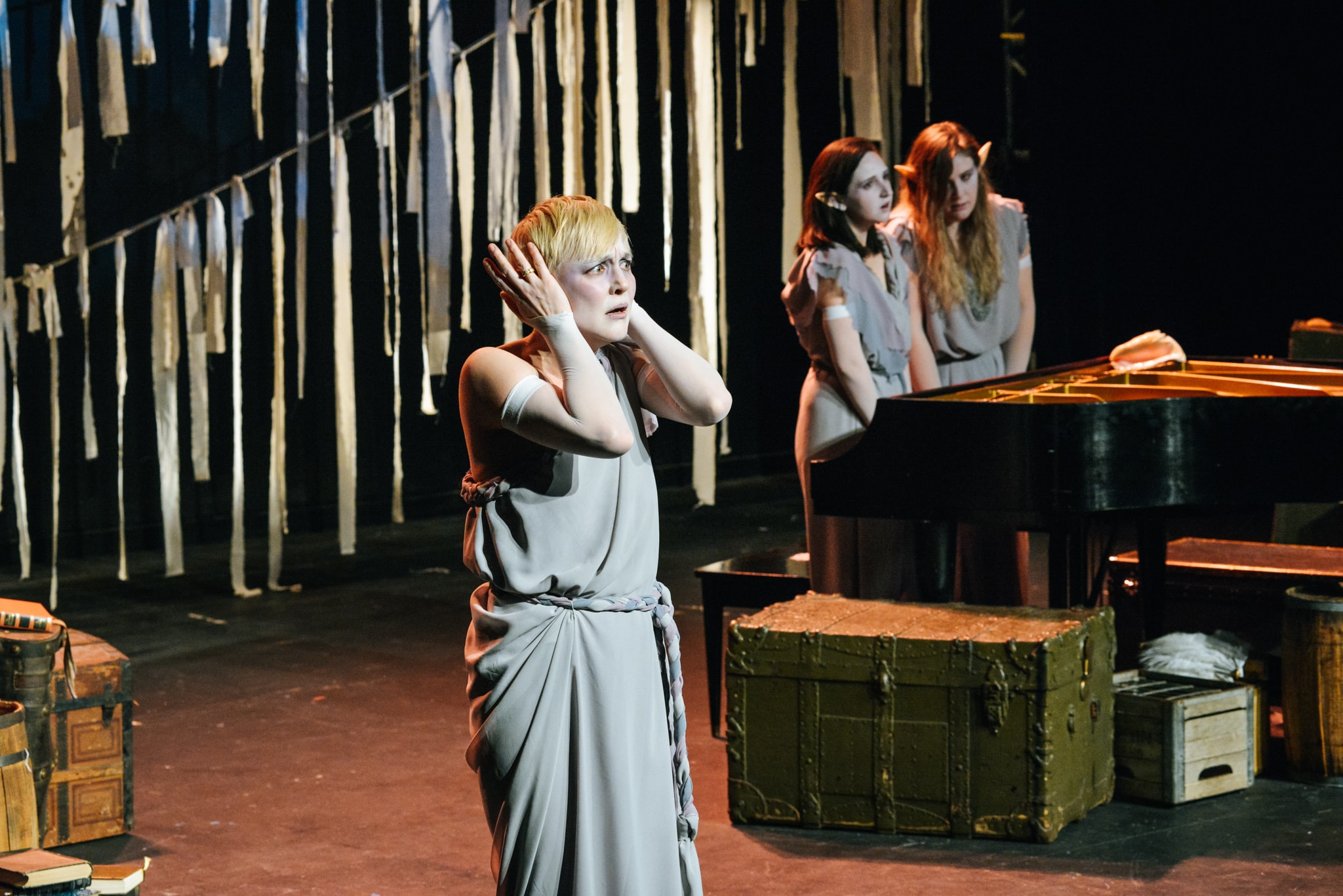‘Here Be Sirens’ is the phrase cartographers used for many centuries to warn sailors of marine dangers. Composer Kate Soper borrowed the name for her musically complex, theatrically rich opera, her contribution to The IN Series’ Women Composers Festival, which just ended.

Soper offers no explanation as to why she chose three sirens as her characters. Perhaps she wanted to remind us that everyone from Homer to Milton to Freud wrote about sirens, mythical creatures indeed, but very real forces in the human psyche. But at least one of Soper’s sirens is different: she is looking for meaning in what seems to be a meaningless life.
As the opera weaves from Plato’s Myth of Er to The Odyssey, the thoughtful festival producers at InSeries provided a useful handout for those whose Greek and Latin may be a little rusty. The handout offers the text in the original Greek, in transliteration, and in English, so you can coordinate what is being said onstage with an English translation.
You don’t really need all that though, because those delightful sirens, with their pointy little ears and their extraordinary, crystal clear voices make clear through their gestures and emotions what they are singing about without additional help.
The siren with the largest part is Polyxo (Noelle McMurty), who darts around the stage looking for a reason for being, while quoting (among others) Simone Weil and Chaka Khan. She is full of anxiety, overwhelmed with the fact that she and her sisters have been charged with luring poor mariners to their deaths. She reads voraciously, is acquainted with every known philosopher, keeps stacks of books along with busts of Aristotle and Athena in her “room” onstage.
Her sister sirens, Peitho (Camille Crossot) and Phaino (Julie Bosworth), are calmer. Peitho is a little frivolous. She’s fond of relaxing on a large trunk, singing sweetly, and admiring her painted fingernails. Phaino is distant, almost reclusive, and spends much of her time listening to a conch shell.

The first reason Here Be Sirens delights is that Soper has brought together so many kinds of music that the opera itself is a vocal kaleidoscope, including: what may be Soper’s imagined vision of ancient Greek singing; what sounds like Medieval plainsong; music that is reminiscent of Renaissance polyhymnic chants; 19th-century operetta; and postmodern minimalist dissonance. Soper is an experienced, educated composer and the unconventionality and humor of her libretto proves it. The production is imbued with a mystery that is well suited to sirens.
The second reason Here Be Sirens astonishes is that the sirens’ voices blend together so smoothly, providing all the music for the opera, either a cappella or accompanying themselves on the piano.
Unlike a conventional quartet or quintet, these three singers are all sopranos. Although the score provides slightly different ranges for their voices – Bosworth’s is the lowest, for instance – they often sing discordant melodies but manage to wind up exactly on the same note.
Whether they sing singly or together, as they do in their tribute to the Muses, McMurty, Crossot, and Bosworth display that they are fully capable of handling Soper’s sophisticated and intricate score.
Director Brian J. Shaw keeps the production flowing smoothly, so that it makes sense, despite its abstract, sometimes complicated material.
Scenic and Projection Designer Jonathan Dahm Robertson has created a suggestive yet clear environment for the sirens. On the rear wall of the GALA Theatre stage, he projects huge, constant waves crashing into a small cove. The waves continue until the end of the opera approaches, when Peitho finds a scroll of Sappho’s love poems.
Center stage is a grand piano with its lid removed. The piano is so central to the opera, it functions almost as a character. It is played, plucked, struck with drumsticks, tympani mallets, and metal drum brushes. The singers often stand very close to the piano, leaning over it to sing. When they stop singing, the strings reverberate. Around the piano, the stage is littered with old-fashioned steamer trunks, suitcases, and boxes, presumably flotsam and jetsam from drowned sailors.
Costume Designer Donna Breslin dresses the sirens in floor-length, pale gray-over-lavender chiffon dresses, belted at the waist, representing a conventional guess of what feminine ancient Greek attire looked like.
Lighting Designer Marianne Meadows divides the opera into short scenes with stark, sudden blackouts. Her subtle lighting over the stage from white to blue represents the movement of the sun, from day to night.
Most people know sirens from Homer. Indeed, Book 12, lines 39 to 47, of The Odyssey are in this piece, warning men not to approach the sirens who “all men bewitch.” Soper has done a magnificent job of creating a mysterious space, where some beings are searching for knowledge of themselves and where others are lost to the deadly lure of sirens’ songs.
Running Time: 90 minutes, with no intermission.
Here Be Sirens played March 7 and 8, 2020 at the GALA Theatre, 3333 14th Street, NW, Washington, DC, as part of The IN Series’ Women Composers Festival.
Credit: Stage Manager Allison Lehman.




